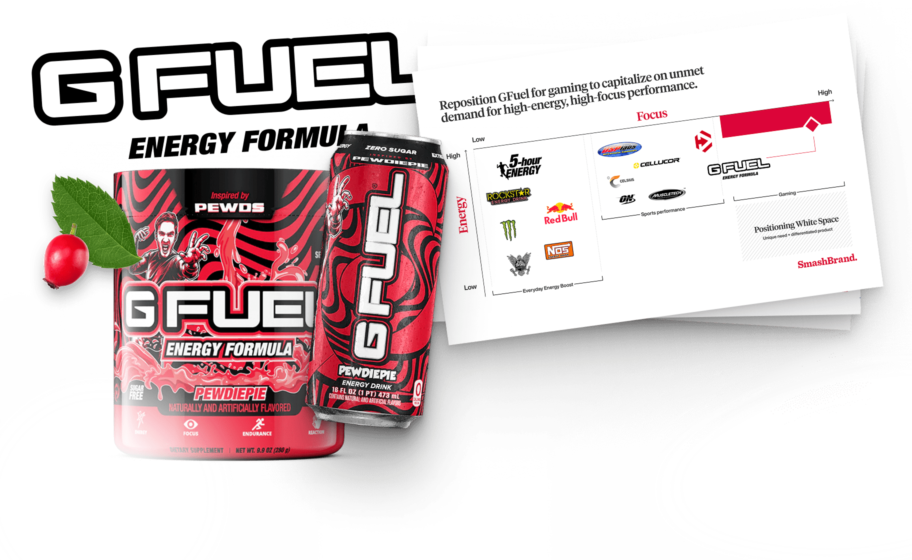When someone gets injured, they ask for a Band-Aid instead of a bandage. That’s because of the company’s strong brand positioning. It is a powerful marketing strategy that helps companies carve out a unique space in the crowded marketplace. It helps make the brand the first choice for the target customer.
Brand positioning is not just a marketing buzzword; it’s a strategic cornerstone that defines where the brand stands and shines in the competitive arena. A well-crafted brand positioning strategy helps companies shape consumer perception and increase growth. But it is easier said than done. Small businesses face many common pitfalls when positioning their brand.
The article breaks down the whole process into simple, bite-sized steps, making it easier to understand. You will learn how to develop an effective strategy for positioning your brand higher and avoid common pitfalls when creating a compelling positioning strategy. So read on if you want to turn the potential customer group into loyal advocates.
What is Brand Positioning?
Brand positioning is the art and science of setting your brand apart. It is how you define your target customer’s perception of your brand. An effective brand positioning strategy sets companies apart from the crowd. It allows them to attract potential customer groups and turn them into loyal advocates for the brand.
It carves a unique, meaningful, and highly relevant niche. The strategic blueprint guides how companies communicate their brand promise, personality, and core values. When executed well, a strong brand positioning elevates the brand above the noise, making it instantly recognizable and preferred by those who matter most to the business.
For example, Screaming Eagle and Opus One are the best examples of price-sensitive positioning in the wine industry. Similarly, Ten Tree and TOMS Shoes are purpose-led positioning examples.
The Evolution of Brand Positioning
The concept of brand positioning has evolved into a sophisticated strategic tool from the early days of simple product advertisements. Al Ries is the marketing mastermind who, alongside Jack Trout, revolutionized how we think about brands. They introduced the concept that a brand should occupy a distinct ‘Position’ in the consumer’s mind.
It was a game-changer. After that, brands no longer competed on features or benefits; they were now vying for mental real estate. They provided a framework for brand positioning examples that continue to inspire today. Even though marketing has changed significantly in recent decades, the concept remains.
For example, think of Volvo as synonymous with safety, or how Apple became the best example of innovation. These brands haven’t just sold products; they’ve claimed positions in our psyche that go beyond the tangible.
Components of an Effective Strategy
- Unique Value Proposition (UVP): What does the brand offer that no one else does? The UVP should be compelling, relevant, and deliverable.
- Understanding the Audience: Dive into the psyche of the target customers. What are their needs, desires, pain points, and aspirations?
- Competition Analysis: Who else is competing for your target audience’s attention? Evaluate their strengths and weaknesses to find gaps that the brand can fill.
- A Strong Positioning Statement: This concise description of the brand encapsulates the UVP, target audience, and how the brand wants to be perceived in the market.
- Communicate Consistently: Every touchpoint with the audience should reinforce the brand positioning. Consistency builds trust and strengthens the position in the consumer’s mind.
- Evolve with Your Audience: Markets change, and so do consumer attitudes. Be prepared to refine the strategy to maintain a resonant brand positioning.
Developing a Brand Positioning Strategy
Developing a foolproof strategy forms the foundation of brand positioning. It guides the process, reduces risks, and boosts the likelihood of success. Creating an approach to services like SaaS that perfectly resonates with the target audience requires thoroughly comprehending the brand’s core, market landscape, and consumers’ thoughts and feelings.
Conducting Thorough Market Research
Detailed market research is the heart of an effective strategy. It helps companies learn about the target audience. Insights from market research and competitor analysis also allow companies to understand their competitors. During this stage, companies gather information and insights about consumer behavior, preferences, and trends.
A company may conduct a survey or leverage social media and focus groups to gather helpful information. Analyzing this data can paint a detailed picture of the target consumers and what they seek in a brand. While researching, companies must focus on successful competitors and carefully study failing brands to see what doesn’t resonate with the market trends.
Intelligent techniques, such as a brand positioning map, can significantly help at this stage. Remember, knowing your target audience is about more than demographics. It’s about psychographics: their lifestyle, values, and beliefs. It’s about understanding their daily challenges and how your brand can solve them.
Develop the Brand Essence Chart
The brand essence chart is an essential tool that simplifies complex brand attributes by creating a clear framework that can be acted upon. It is a strategic tool that aligns your brand’s identity with your customers’ perceptions and emotions.
By organizing the critical components of your brand’s essence, you create a reference point that informs branding decisions, such as copywriting and design, ensuring consistency and resonance with your audience.
Here is a detailed look at the components of a brand essence chart:
| Component | Description |
| Attributes | Product/service features, such as functionality or user experience, can be physical or non-physical. |
| Benefits | This column lists customers’ benefits from your brand’s attributes, including functional and emotional ones. |
| Personality | Describe your brand’s character using unique adjectives to help it stand out in the marketplace. |
| Source of Authority | Brand credibility comes from its history, expertise, accolades, research, and customer endorsements. |
| What It Says About You | Consider your brand choice and your status, values, and aspirations. |
| How It Makes You Feel | Know the emotions your brand evokes in customers. It can differentiate your messaging strategy. |
| Positioning/Essence | Summarize the key takeaways for the customer in a concise statement to guide your brand’s messaging and positioning. |
The brand essence chart is a living guide that evolves with your brand and market dynamics. It ensures that every aspect of the brand strategy is rooted in a deep understanding of what it stands for.
Crafting a Strong Brand Positioning Statement
The stronger the brand positioning statement, the better it will position itself. Crafting a compelling positioning statement distills the brand’s essence into a few powerful sentences. During this stage, companies must first define their unique value proposition.
It helps the brand distinguish itself from hundreds of me-too brands. At this stage, companies must effectively utilize insights obtained from market research. They must ask basic questions like who the target audience is and what they care about. How does the brand or product solve its problems?
Analyze the competitors’ positioning statements to generate ideas. This step helps identify areas where the brand can stand out and ensures that your positioning statement highlights your brand’s unique strengths in the market context.
The brand promise is a commitment to your customers. It’s what they can expect from every interaction with your brand. The positioning statement should reflect this promise and the experience of fulfilling it.
Leveraging Brand Architecture
Brand architecture is the organized system of relationships between the parent brand, sub-brands, products, and services. It is a blueprint that defines the hierarchy and informs how a customer understands a brand and its extensions. It is crucial because it clarifies the offerings for the consumers.
It also helps to avoid confusion in the marketplace when a brand has multiple offerings. A company can strategically market its products without diluting the brand equity or confusing the consumer by having a clear brand architecture. An effective architecture supports a strong brand identity, which is the visible element of the brand.
When integrating brand architecture into the brand positioning strategy, consider these key factors:
- Alignment with Business Strategy: The architecture must align with business goals, supporting growth through new product introductions, market expansion, or customer targeting.
- Clarity and Simplicity: Create clear and logical relationships between the parent brand, sub-brands, and products to ensure easy understanding.
- Flexibility and Scalability: As markets evolve, the brand architecture should accommodate new products and brands without becoming convoluted.
- Consistency in Brand Identity: Consistent brand identity across all sub-brands and products reinforces parent brand values and promises.
- Strategic Brand Positioning: Each product must have a distinct position to meet specific market needs without overlapping with other brand offerings.
- Leverage Brand Equity: Sub-brands can use the parent brand’s equity while also building their own equity, which can reinforce the parent brand.
Defining The Brand’s Core Values
Core values are the guiding principles that drive a brand’s culture, decision-making processes, and customer interactions. They serve as an ethical compass, representing what the brand stands for and believes in. These values include innovation, sustainability, customer-centricity, integrity, and quality.
Creating a relatable brand personality means giving the brand human-like qualities to make it more relatable and appealing to customers. The brand personality can be friendly, professional, quirky, rugged, sophisticated, and other similar characteristics. It is communicated through the brand’s tone of voice, visual identity, and how it interacts with its audience.
A brand’s story is an integral part of its personality. It tells the story of the brand’s beginnings, goals, obstacles, and triumphs, building a solid emotional bond with the audience. This narrative gives the brand context and significance, helping customers understand its journey and become invested in its success.
Aligning Product Positioning with Brand Strategy
Creating a coherent brand narrative requires brands to align their product positioning with their overall brand strategy. Effective positioning should complement the strategy by reflecting its values and promises.
Brand positioning examples demonstrate how individual products reinforce the brand’s image and messaging. Consistency in product positioning across all products helps to strengthen the brand’s identity, making it more straightforward for customers to understand and engage with the brand.
Utilizing a Brand Positioning Map
A brand positioning map is a visual tool that helps identify how your brand is positioned in the market compared to competitors. It plots your brand against competitors based on various dimensions that matter to customers, such as price, quality, innovation, or customer service. This tool helps to identify gaps and opportunities for differentiation.
By analyzing your brand’s position on the map, you can make strategic decisions to reposition your brand, strengthen your current position, or explore new market segments. A brand positioning map is a powerful way to understand market dynamics and strategically direct your brand’s efforts.
Integrating Positioning with Marketing Strategy
Integrating positioning ensures that the essence of the brand’s positioning is woven into every marketing activity. It creates a unified brand image that stands out to the target audience.
Companies must focus on developing a consistent message that aligns with the brand’s positioning and choosing the appropriate channels to reach the audience, which are critical steps. It’s essential that every piece of marketing collateral, whether online or offline, reinforces the brand’s positioning.
Monitoring the effectiveness of these strategies is necessary to ensure they continue to support the brand’s positioning goals, with adjustments made as needed. Companies often encounter the following challenges at this stage:
- Evolving market conditions
- Ensuring internal buy-in
- Understanding of the positioning strategy
- Allocating sufficient resources to support the strategy across various channels
- Shifting customer perceptions
- Reacting to competitive strategies.
Building Brand Awareness
Brand awareness is an essential component that helps to skyrocket the brand positioning. Companies can leverage the power of social media and digital marketing to reach potential customers. These tactics can help them spread brand awareness more effectively.
Imagine this: With over 4.6 billion people using the internet, the potential for reach is enormous. Social media alone can skyrocket brand recognition, as an average person spends about 2 hours and 25 minutes on social platforms daily.
By crafting compelling content, interacting with users, and using targeted ads, brands can turn casual browsers into loyal followers.
SEO is another powerhouse. Around 68% of online experiences begin with a search engine. By optimizing content for search, brands can climb the ranks in search results, capturing attention right at the moment of intent.
Let’s not forget the might of email marketing. With an average ROI of $42 for every $1 spent, it’s a direct line to consumers, keeping them engaged with personalized content.
And influencers? They’re the new-age celebrities. About 49% of consumers depend on influencer recommendations. Partnering with the right personalities can catapult a brand into the spotlight overnight.
Measuring and Maintaining Brand Positioning
After implementing the brand positioning strategy, companies must develop a proper benchmark system for testing. Measuring the success of the implemented strategy is crucial to determining its effectiveness. Companies can use measurement data to fine-tune their strategy further.
Companies often rely on a robust brand positioning framework to ensure a strong brand position. This framework is a strategic guide for all brand-related decisions and communications and helps identify the unique value propositions that set a brand apart in the marketplace.
Quality-based positioning is a powerful approach within this framework. It focuses on the brand’s ability to deliver superior value through excellence. Brands that consistently deliver on their quality promises can solidify a strong position in the consumer’s mind, increasing loyalty and competitive advantage.
Tracking Brand Perception and Loyalty
Companies can track brand perception and loyalty by actively engaging with their customers and analyzing their interactions with the brand. This process is essential for measuring the effectiveness of brand positioning and involves several steps:
- Regularly conducting surveys to gather customer opinions on the brand’s products, services, and overall image.
- By analyzing social media content such as comments, shares, and likes, companies can gauge public sentiment and identify brand advocates or detractors.
- Encouraging customers to leave reviews and paying attention to these ratings can provide direct feedback on customer experiences and perceptions.
- Implementing loyalty programs helps track how often customers engage with the brand and the extent of their loyalty.
- Measuring NPS using Net Promoter Score tools gives companies a clear idea of their customers’ willingness to recommend their products or services, strongly indicating brand loyalty.
- Addressing customer concerns and making improvements based on feedback is crucial for maintaining brand loyalty.
Challenges in this process can include:
- Data Overload: With so much data available, it can be challenging to filter out the noise and focus on the most relevant feedback.
- Bias in Responses: Customers who respond to surveys or leave reviews might not represent the entire customer base, leading to skewed perceptions.
- Keeping Up with Real-Time Feedback: The speed at which feedback is generated, especially on social media, can be overwhelming for companies to track and respond to effectively.
- Integrating Feedback Across Departments: Ensuring customer feedback is shared and acted upon across different business areas can be difficult, particularly in larger organizations.
Conducting Ongoing Brand Research
Conducting ongoing brand research is vital for businesses to stay informed about market trends and to make necessary positioning adjustments. This continuous process helps companies understand consumer perception and ensure their brand remains relevant and competitive.
Brand research involves several key activities, such as:
- Regularly examining the broader market to identify trends, changes in consumer behavior, and emerging opportunities or threats.
- Observing competitors’ strategies, strengths, and weaknesses can inform how a brand differentiates itself.
- Engaging directly with consumers to gather insights into their perceptions, needs, and expectations from the brand.
- Conduct in-depth discussions with smaller groups of consumers to understand their attitudes and reactions to the brand and its positioning.
- Utilizing tools to monitor social media and online conversations for real-time insights into what people say about the brand.
- Analyzing sales figures and other performance metrics to gauge the brand’s health and the effectiveness of its positioning strategy

Path to Performance™
Taking a results-obsessed approach to CPG package design.
Learn how SmashBrand’s proprietary process – rooted in scientific principles, informed by data, and validated by your target audience – takes the guesswork out of package design and delivers guaranteed results.
Brand Positioning in Packaging Design
While most know us at SmashBrand for packaging design and consumer testing, much of our client work helps us determine the target customer and create packaging that aligns the potential customer persona with the intended brand perception.
As your brand positioning agency, our package design testing process will create a strong brand image and a brand positioning framework you can use across your entire product line. Book a time to discuss your project with our team.

Nice Package
Don’t miss out on our monthly newsletter Nice Package!
Each month, we deliver a data-driven newsletter directly to your inbox, unpacking a critical topic in the FMCG & CPG industry.
"*" indicates required fields
Subscribe to
Nice Package.
A monthly newsletter that unpacks a critical topic in the FMCG & CPG industry.
Free Resource.

CPG product repositioning guide.
Explore the five undeniable signs your CPG product needs repositioning along with strategies for leveraging consumer insights for a guaranteed market lift.
Learn More About CPG product repositioning guide.



